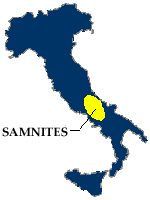The Samnites
"They did not escape the war and they preferred rather to suffer a defeat than not try by every means the victory" (Tito Livio, X, 31)
The Samnites
We know a few vestiges and we have short historical witnesses of the Samnites. The only signs are the discovered archeological reperts and the stories of the ancient Rome's historians that were enslaved to party in power. So these historians worried too much to praise the conquests of the Romans and described very little the Samnites and the Samnium.

The politics
The Samnites were politically constituted by four tribes. Each tribe was named Touto; it was constituted by several dwelling groups and was managed by the Meddix Tuticus , that had a roll about the established religion. The political unit lower to Touto was the Pagus that was composed by several dwelling groups. It is probable that each pagus was administered by a Meddix Minor, subordinated to Meddix of the Touto. The town located on the palin was named vicus, while that of the mountain scenery oppidum and it was always fortified. Trebula was an oppidum of the Caudini's Touto. The other three toutos were those of the Carricini, Pentri and Irpini. At the end of fourth century B.C. the Samnites had to face the serious threat represented by the expansionism designs of the Romans. The toutos organized oneself making up the Samnite League .
The economy
The most profitable economic activity was the agriculture, the breeding, the wool's and skin's working; the working of the cheese products was important too, because they were extensively traded in the territories of Campania and Puglia. All these products acted as exchange goods for all others wich weren't produced on the spot but they were imported. The Samnites came into touch with the people of Campania and that improved the trades and the learning of them. Moreover, the cult of the Samnites was influenced by the Greeks. Trebula, as all outskirts places of the Samnium, developed most likely an economy beyond that of sheer subsistence.
The society
Both the climate and the sheep-breeding involved to use woollen garments. The women worked these garments by the spindle and then sold them. The Samnites almost always used bronze ornaments, seldom gold or silver ornaments. The women wore rings, round-necked necklaces and bracelets. Some bracelets had a spiral shape and ended by a snake's head, as the discoveries into a lot of samnite tombs show. The men wore bracelets with various representations as animals or geometric shapes; they had a short hair, shave and used large tunics tightened at waist by a metal or hard leather belt. The belt meant that they had cost of age and they were ready to defend their territory.
The language
The language of the Samnites was the Oscan this term derives from "Osci", the people that preceded the Samnites in the Centre and South Italy. It was an autonomous language so widespread that it was understood by the Samnites, the Lucani and the Mamertini that spread it north of Sicily where the Greeks were settled. The oscan grammar was like that latin but the two languages differed from one another in orthography and in sound of the words. Unfortunately, apart from a few epigraphs, no literature's books reached us but only testimonies and fragments handed down by roman men of letters.
The religion
The religion was important for the civilization of the Samnites as to be an element of unity. In fact, all samnite toutos worshiped the same divinities and, in case of war, the soldiers took sacred oath that never was violated. In the army of the Samnites there was a special army corps named "Legio Linteata" ; after a sacred ceremony, the warriors swore to sacrifice their life just to defend their country against the enemy. The Samnites worshiped the same divinities as the people of the Centre and South Italy: Jupiter, Mars, Apollo, Mercury, Diana and so on . There were no veneration places for each divinity, but all divinities were worshiped in the same holy place. The "Tavola di Agnone" , an Oscan inscription, shows that 17 divinities were worshiped in the same holy place; the holy places were far away from the dwelling groups and had a square shape ; in the middle of them there were usually an altar and other elements as sacella, wells, tubs and all should be essential for the rites. At first they were simple open-air holy places with lasting steel construction quite modest or even absent. After the punic wars, the building of the temples began to expand. A lot of temples were endowed with architectonic structures because of the damages caused by the wars.
The necropolisses
The dead person was buried in supine position and the crockery was often put down on him with a form depending on social condition of the dead person. Between the fifth and third century B.C., the tombs were simply graves dug in the ground, on both sides of them there were tufaceous parapets and the tombs were usually covered by two tombstones. Subsequently they began to use tiles and big tiles to cover the grave. The tombs often had an arrangement so the feet of the dead person were oriented in the East-West direction. From examinations of the skeletons we can realize about the life conditions at that time; they were rather difficult because the average age was 40 years. The ceramics used in the tombs of the fourth and third century B.C. were mostly imported from Campania, but not seldom it was produced in the same utilization zone, as several furnaces discovered in the samnite territory show. Some of them were discovered at Treglia, at slopes of Mount "Castello". They have a circular plan 4 m in diameter with a wide praefornium. Therefore, these furnaces show that the Trebula's inhabitants bore in their zone the crockery used as funeral outfit, as domestic tools and for the rites .
